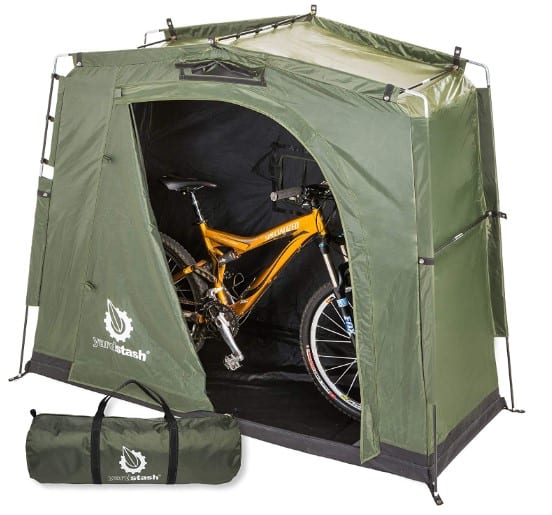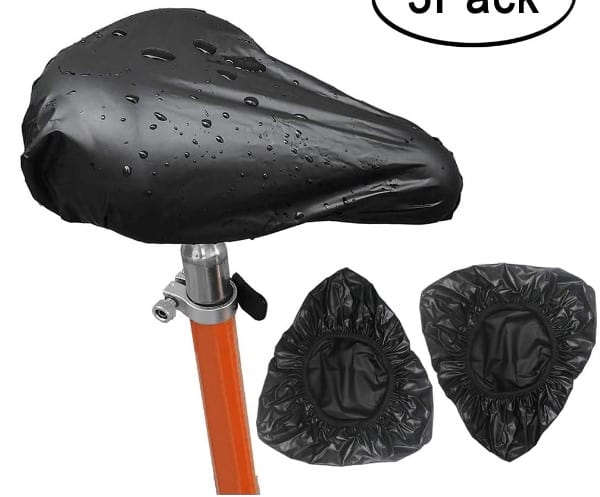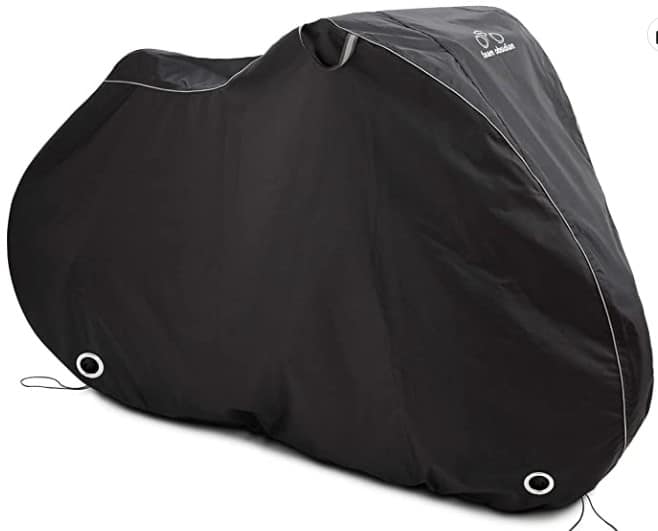The rain season is here, and you are probably afraid that your bike will be rained on. And since you leave it outdoors, you cannot help but wonder, is it bad to leave a bike in the rain?
Yes, if you leave your bike in the rain for a long time, water will get into the moving parts, the bike electronics, and the brakes. Not only will these parts become less efficient, but they are also likely to rust and wear down. The other part that’s likely to rust from rainwater is the bike frame.
I’ll explain what happens to all these parts after your bike is rained on and what you can do to protect your bike. Let’s start!

So, Is It Bad To Leave A Bike In The Rain? The Risks
As I mentioned in my introduction, leaving your bike in the rain is not advisable. You are likely to reduce its performance and shorten its life faster.
In particular, rain is likely to affect the moving parts, bike electronics, frame, brake, and saddle, as I explain below.
1. Moving Parts Becoming Less Efficient And Are Likely To Wear
The bike chain, derailleur, and gears are likely to attract dirt and mud when it rains. And once that happens, they become less efficient in performance and are more likely to wear.
The best approach would be to shelter your bike, but if that’s not possible, you have to ensure you clean off and lubricate the moving parts after it rains.
2. Bike Electronics Likely To Get Damaged
Though most bike electronics like lights and bike computers are waterproof, it’s only to a certain degree.
Essentially, you can determine the water-resistance level of your bike electronics by looking at the Ingress Protection (IP) Rating.
Sadly, most bike manufacturers don’t advertise their Ingress Protection score, which means you’ll have to use your judgment. So, instead of taking the risk, ensure you shelter your bike.
3. Bike Frame Likely To Rust
Rainwater is an enemy to your bike’s steel frame and even aluminum if it’s not rust-protected. Rust is likely to weaken the bike frame, and before you know it, it will be breaking.
Luckily, most steel frames come painted to resist rusting. But if the paint layer is starting to peel off, which will happen at some point, the bike frame is susceptible to rusting when it rains.
However, if the frame is carbon fiber or powder-coated aluminum, you wouldn’t have to worry about rust.
4. Brakes Becoming Less Efficient
The other sensitive component that you wouldn’t want to get wet is the brakes. Remember, the brakes work by pressing the brake pads against the wheel.
So, if rainwater or mud gets between them, then the brakes won’t work well. Note that this issue is common with rim brakes.
You may not have to worry about it in the case of disc brakes. That’s because rainwater finds it hard to get between the brake pads and the wheel.
5. The Seat Wearing Out
Rainwater can damage the bike seat. That’s if the bike seat doesn’t feature a water-resistant cover.
You could get a plastic bag and wrap it around the bike seat, but this could be a lot of work.
To save time, consider getting a waterproof bike cover like the Kalannder Waterproof Bike Saddle Cover.
This bike seat cover doesn’t just keep your saddle dry, but it’s also scratch-resistant. Moreover, it’s elastic to fit any bike saddle and comes as a three-pack for your convenience.

What Do You Do With Your Bike After It Rains?
Suppose you couldn’t do anything to prevent your bike from being rained on. What should you do?
Here are the tips that I recommend:
1. Get the gunk/grime off
It would help if you got rid of water drops and mud from your bike after it rains. You can do that by first bouncing the bicycle on the ground and then clean with soap and water.
You can also use a hose to flush out mud from the corners.
2. Clean the moving parts
You also need to get rid of dirt and mud from the bike’s moving parts. That includes the brakes, wheels, and gears.
If you cannot do it with soap, use alcohol as it’s more effective against stubborn dirt and grime.
3. Dry off the bike
After cleaning your bike, you’ve to dry it properly. You can use a dry cloth and later leave your bike in the sun for a few minutes to properly dry it.
Ensure you don’t keep it under the sun for long hours to avoid fading the paint or making the plastic parts brittle.
4. Lubricate it
You must lubricate the bike’s moving parts after cleaning them. In particular, ensure you grease the chain thoroughly, and you can use the Finish Line Dry Teflon Bicycle Chain Lube.
It’s an effective chain cleaner against dust, grime, and grit. That’s in addition to reducing chain wear.
The other parts to lubricate are the derailleur, gears, and brakes. Overall, ensure you always lubricate the moving components to boost your bike’s life.
How Should I Protect My Bike From The Rain?
I usually advocate keeping the bike indoors. If you have a garage or a basement, consider keeping your bike there during the rainy season.
However, if you have no such space and your bike has to stay outdoors, then consider taking any of these preventative approaches:
a) Invest in a good bike cover
If your bike has to stay outside during the rainy season, you’ve to protect it against rust. Well, there is no better way to do that than to use a bike cover.
Bike covers are easy to use, and they offer protection against heavy downpours and intense sunshine.
One example is the TeamObsidian Waterproof Bike Cover.
This weatherproof bike rain cover can hold up to 3 adult bikes. It protects against the rain, UV rays, snow, dust, and dirt.
The TeamObsidian Waterproof Bike Cover comes in durable fabric, and it’s generally secure, given that it comes with lock holes.

b) Cover the bike with a waterproof tarp
A waterproof tarp is an excellent alternative to a bike cover. Therefore, it protects your bike against harsh weather, including heavy downpours and the intense sun.
One waterproof tarp that I highly recommend is the Tarp Cover Heavy-Duty Thick Material.
Not only is that tarp waterproof but also tear-resistant and durable. What’s more, it comes in a vast size, enough to cover a pool or boat.
c) Keep the bike in an outdoor bike shed
You can also make an outdoor storage shed for your bike to protect it from bad weather. Alternatively, you can buy a ready-made bike shed like the YardStash IV Space-Saving Outdoor Storage Shed (View on Amazon).
This bike storage comes in an easy-to-fold, space-saving, lightweight design to allow you to take it with you anytime.
It assembles and folds down in seconds, and it’s all tool-free. Not only will this bike storage protects your bike from the rain but also from dust and pests.
You can keep two or more bikes there. The best part is that you can secure the storage shed to the ground using its eyelets.
FAQs On Is It Bad To Leave A Bike In The Rain
1. Is It Bad For Bikes To Be In The Rain?
If you cycle in the rain, it’s likely to get slippery and ultimately unsafe for you. However, this is not the only bad thing that could happen.
Your bike, especially its frame and moving metal parts, are likely to rust and wear out faster. Water droplets are also likely to damage the brakes, chain, and derailleur.
So, it isn’t suitable for a bike to be in the rain.
2. Should I Dry My Bike After Rain?
After it rains, your bike is likely to have accumulated rainwater and sometimes grime from the muddy road. The problem with such buildups is that they can lead to rust, and rust will eat away your bike.
So, ensure you clean and properly dry your bike after it rains.
3. Do Bike Covers Prevent Rust?
Rust occurs when water reacts with iron in the presence of air. Yes, a waterproof bike cover can prevent rust. A bike rain cover protects your bike from rain, inhibiting rust.
4. Can A Bike Be Stored Outside?
Yes, a bike can be stored outside. You, however, have to ensure that the outdoors is secure. The other essential is to ensure that the bicycle is weather-protected.
You would want your bike to get stolen or rust after it rains. So, secure it firmly and cover it with a bike cover or tarp. Alternatively, lock it in a bike shed.
Relevant Post:
Closing Thoughts:
So, is it bad to leave a bike in the rain? If I were you, I wouldn’t leave my bike outside during the rainy season. I would rather keep it indoors.
But if you have to leave it outdoors during the rainy season, consider using a bike cover or tarp or storing the bike in a storage shed.